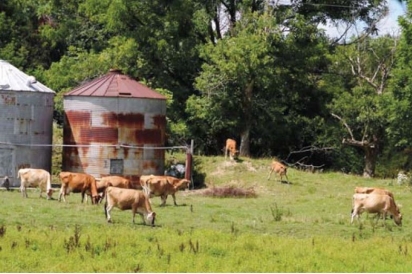Making Bread is Simple at Hampshire Farms
Late on a Friday afternoon in high summer, Randy Hampshire is covered in flour. He has been busy processing wheat in his 1917 Meadows grain mill and getting ready for the Saturday morning farmers’ markets. His wife, Shirley, has just finished up baking loaves of spelt bread in her wood-fired brick oven and is waiting for them to cool before packing and labeling each one.
Across the field, their lively dairy cows graze in the rolling grasses, looking up occasionally at a few rumbles of thunder off in the distance. There is a quiet contentment in the air as Randy and Shirley work purposefully at the tasks of the day.
With every step along the pathway to the milking barn, Randy can’t help but think about the footsteps of his father and grandfather who farmed this land. “I’m a fourth-generation farmer,” he says. “I’ve been farming all my life.”
His great-grandfather purchased the land in 1896. Randy inherited both the land and the passion for farming. He studied agriculture at Michigan State University and worked on a nearby organic farm before returning home to start his own venture with Shirley.
“I knew that commercial chemical farming wasn’t what I wanted to do,” he says. “So we moved back to our home farm and I started farming organically.” First, they raised soybeans, edible beans, corn, wheat and spelt. Then they added hard red winter wheat, buckwheat and open-pollinated corn, which Randy stone ground and sold at the Royal Oak Farmers’ Market and at Detroit’s Eastern Market.
One day, he met a man named Bud, who regularly purchased 500 pounds of wheat from a neighboring farm. “He told me that he had a flour mill and wood-fired oven and liked to bake bread. I asked him if we could come up and see what he was doing,” Randy says.
“That was the first time I ever tasted bread. I didn’t know you could make it with just flour, water and salt. He gave us some of his sourdough starter and taught me how to build a brick oven. That’s how we got started.”
Shirley has a different memory. “When we met Bud, I thought Randy was going to be the one baking the bread, but since then, he has baked zero loaves. I was led astray,” she says with a smile. Their goal was to make sourdough bread with their own freshly milled wheat and provide a healthier alternative to their customers than big puffy loaves of refined white bread.
This is no small challenge, Shirley explains. “Making a loaf of French bread is simple, but this bread is not so simple. There are many variables that can affect things, such as the age and quality of the grain, the gluten content, the air temperature and the temperature of the tap water.” Though each batch comes out slightly different, Shirley has clearly mastered the art, Randy says. “I tell people, you eat this bread—it can change your life, if that’s the one thing you change in your diet.”
Over the years, the couple has diversified their operation, as they’ve figured out what works best. About four years ago, they started selling raw milk dairy shares, as customers kept inquiring about milk. “With the dairy, I started very cautiously,” Randy explains. “I attended the International Milk Symposium and started with two cows. I had to learn dairy in a new way.”
“It’s really something. Our customers are really happy to get nutrient-dense food. When I go to the market it’s about supplying good food to them. We want to make a difference, because our food system is broken.”
Today, the farm has 150 cow shares, which they deliver on Tuesday evenings and during Saturday market hours. “I like knowing the families eating our bread and our milk,” Shirley says. “It’s a good feeling to know that on Sunday morning, they’re slicing up our bread and having it for breakfast.”
The farm has been certified organic since 1988, but this year, they’ve applied for Biodynamic certification—a holistic form of agriculture that creates a diversified, balanced farm ecosystem. Their farm will be one of the first in the area, Randy says. Creating a thriving business based on these values has been a labor of love.
“It’s taken 30 years to get here. Quite often, I see all the things that need to be done, but I go up on that hillside and I look at all the things we have now—these were the things I had only hoped for,” Shirley says. “Twenty years ago, none of these buildings were being used, but now we’re using all of these things. It came over time. Everything seems to fit and work together.”
Their two children, Amalie and Brandon, both work alongside their parents on the farm, and their three grandchildren are growing up on the farm. “Our families have been farming for two centuries,” Shirley says. “There is too much blood and sweat on this land to let that go. Our farm plans to be at the market a long time.”
Learn more at HampshireFarmsOrganic








